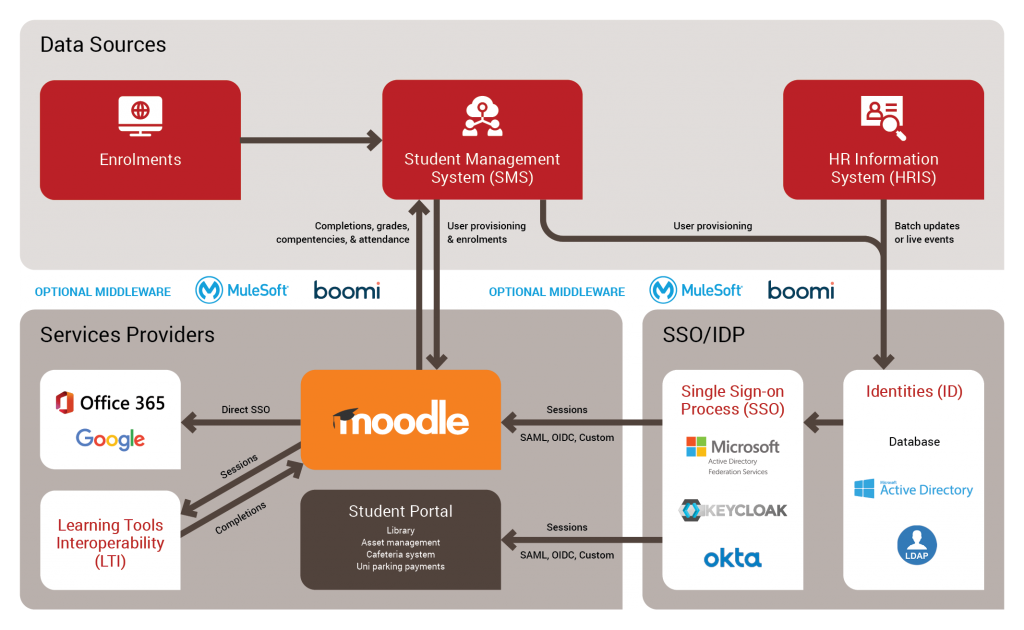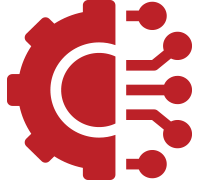Moodle integration for Architects
This post explores Moodle integration from a solution architecture perspective. Moodle is a highly extensive learning management system (LMS). It scales to a variety of use cases, from small, on premise, highly targeted solutions for small businesses, to a fully integrated cloud-based solution for universities servicing the academic needs of thousands of students and hundreds of faculty staff. The way you architect a Moodle solution is what matters here.
Should your organisation need a fully integrated LMS solution, that is integrated with your student management systems, identity and access management solution and your HR and enrolments systems, you need to identify and build to deliver on these requirements, as foundational functionality in your deployment model.
Understanding integration
A crucial aspect of solution architecture, when designing any system, is that you take time to analyse the integration requirements fully. You need to cater for information flows and signalling between components where these systems rely on information contained within the other elements in the business.

The Figure 1 example shows Moodle as the core LMS platform integrated with Microsoft 365 and Google cloud services, and the university’s student management system (SMS). Further identity management integrations allow the university to provide single sign-on (SSO) using Okta and Microsoft authentication, with Active Directory providing a unified identity source for students, faculty staff and administrators.
Integration in this type of deployment model requires that you implement protocols that interoperate across all these platforms, such as using SAML for identity and access. An administrator with API and security architecture knowledge can deploy the SAML plugin for Moodle. However, there are complexities with all integration projects and the devil is always in the detail.
Before embarking on a business-critical Moodle deployment solution, we’d recommend that you consult with experts that have experience of these sorts of projects, at scale. Misconfigurations in any of the workflows or components can leave you exposed to systematic failures, issues with information synchronisation and, worse, security issues that leave your student information exposed to external threats.
Moodle integrations

Certified Moodle Integrations
If you’re an Architect designing a Moodle LMS deployment for your organisation, we’d recommend that you begin by assessing whether any of the Certified Moodle Integrations will assist in the solution.
Certified Moodle Integrations are add-ons that have already been developed by Moodle experts. They extend the architecture with external services, such as Poodll, Ouriginal, IntelliBoard and BigBlueButton. Each of these integrations allows you to add functionality to your solution, such as Ouriginal’s ability to check user-submitted content for plagiarism.
Beyond the small list of Moodle Certified Integrations, the Moodle website reports more than 1,900 open-source plugins developed by the Moodle community to extend the platform’s base functionality. Given this vast number of plugins, most common use cases have already been identified and a solution developed.
Before trying to build your own integrations, we’d suggest that you search the Moodle plugins database first. For example, if you are looking to extend the capability of the base solution with additional student tracking, searching on the term ‘student management’ provides dozens of useful plugins. One such capability is the Student Tracker plugin that allows you to view how many students have not attended their course for an extended period of time. Armed with this information, educators can reach out to the targeted list of students involved to try and identify any problems and offer support to get the students back on track. Student retention is a key priority for everyone in education, so identifying issues early and intervening quickly can be what recovers a situation that may otherwise have become irretrievable.
Many Moodle plugins are straightforward to integrate and manage, however, there are complex integrations that need more consideration and deployment planning to ensure they work as expected. After all, you don’t want to introduce security weaknesses or instabilities in the platform that could end up damaging your organisation’s reputation. This is where knowledge of APIs becomes critical, since broader interoperability across platform stacks, with potential integration between on premise and cloud-based solutions, are required to complete the solution.
The Importance of APIs in Moodle integrations
Moodle has several APIs that help architects to extend its capability outside of the core platform deployment. APIs allow solution developers to bring together Moodle capabilities and information stores on external platforms to synchronise data or signals from external sources. These APIs are the core programming interfaces for Moodle plugins and are used by solution developers should an existing plugin not meet their needs. For example, the Data Manipulation API would be used by a developer to access and interact with Moodle database content, using a guaranteed, safe solution that works with many different records and database management systems.
Big data
Scaling your Moodle platform to an enterprise grade solution will almost certainly require you work with an existing information management solution, where information repositories are installed in large-scale cloud-based platforms, or custom data lakes.

The term ‘Big Data’ usually refers to large volumes of data, with a high rate of change, covering both structured and unstructured information artefacts. Analysis of Moodle data at scale allows administrators and faculty experts to make more effective decisions on strategic business changes, such as class efficacy, enrolment issues and even predictive outcomes on marketing campaigns. This situation requires the use of new tools, such as Hadoop, which is suitable for managing data at scale.
With the Apache Hadoop framework, you can start interrogating massive data sets across computing clusters using simple integration models and Moodle’s APIs. Rather than using Moodle’s built-in database to analyse your student data for patterns, you can scale up from single servers to hundreds of systems running in parallel to run machine learning and artificial intelligence algorithms.
Architecture as a discipline
The reality of building an integrated application architecture is that while it enables Moodle deployment at scale and interoperability with many different platforms to solve the most complex learning problems, you will need to have the requisite technical skills in modern application development techniques to be successful. We would recommend that you work to develop your skills in Agile development, and build a deep understanding of DevOps and DevSecOps, cloud computing architectures, API services integration, and CI/CD pipelines.
Catalyst support for Moodle integration projects

The Catalyst Team of integration and infrastructure experts has acquired and developed architecture skills over many years spent on the development of large scale Moodle deployments, both on premise and in the cloud. We have a broad set of skills in Big Data planning, API and Moodle Plugin development, and a team of solution architects who know precise deployment patterns and all the pitfalls of managing solution components at scale.
If you’d like to leverage our expert knowledge to get your integration project up and running quickly and effectively, please get in touch.

